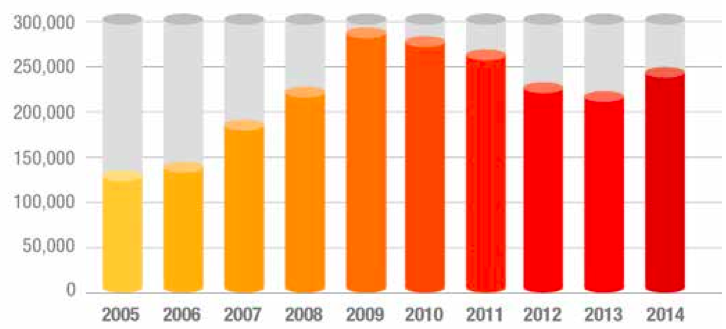Outbound Indian student numbers have bounced back from four years of decline with a year of rapid growth to break the 300,000 mark in 2014, an in-depth report on the sector has shown.
News and business analysis for Professionals in International Education
Have some pie!
Outbound Indian student growth overtakes Chinese for the first time
 Outbound Indian student numbers have bounced back after four years of decline.
Outbound Indian student numbers have bounced back after four years of decline. The 10.1% growth meant the number of outbound students from India grew faster than the number from China for the first time ever last year, the Indian Students Mobility Research Report published by New Delhi-based market consultancy firm M.M Advisory Services shows.
“This means that international student market dynamics is going to be even more driven by China and India”
Maria Mathai, M.M founder, noted that outbound movement from South Korea, which along with China and India accounts for more than 50% of the global outbound market, is falling.
“This means that international student market dynamics is going to be even more driven by China and India, with India proving more momentum now than it has in the past,” she commented.
New Zealand has seen the sharpest proportional increase in incoming Indian students, with a staggering 49% jump, fuelling overall international student growth in the country of 12% in 2014.
The unprecedented increase, the result of a concerted push for Indian students by Education New Zealand, could see the country overtake the UK within a year, the report predicts.
Australia, however, is the “biggest game-changer” globally, also thanks to ramped-up marketing efforts in the country, reaching more than 63,000 in 2014.
 The 28% growth of Indian students in Australia follows four years of decline, and Mathai said she was surprised at the extent of the recovery.
The 28% growth of Indian students in Australia follows four years of decline, and Mathai said she was surprised at the extent of the recovery.
Meanwhile, revised statistics from Citizenship and Immigration Canada for the country’s 2009-2013 international student intake (2014 figures are yet to be released) reveals that numbers are up to 30% higher than estimated in the past.
This is due to CIC recently adopting the model used by many other countries of counting all study permits issued to international students during the calendar year, rather than taking stock at the end of the year.
“Canada’s revised statistics for previous years also were also a pleasant surprise as they show a healthy growth rate for Canada in recent years, more than what we had previously assumed,” Mathai commented.
“From a global perspective, the high degree of correlation between Australia’s loss with Canada’s gains was extremely interesting,” she continued.
The report states that the Canadian education sector has gained incrementally more than 35,000 Indian students between 2009 and 2013 as Australia has lost some 48,000, with the correlation suggesting that 75% of the numbers lost by Australia went to Canada.
“From a global perspective, the high degree of correlation between Australia’s loss with Canada’s gains was extremely interesting”
As such, Australia’s resurgence could have a knock-on effect in Canada as it spurs global competition for Indian students, it predicts.
Australia’s bounce-back has already had an impact, even on the US, the most popular destination for Indian students.
Still, M.M. Advisory Services predicts that the US will break the one million international students mark by 2017.
Growth in Indian student numbers coming to the US stood at 6.1% in 2014, compared with overall international student growth of 8.1%. In comparison, Australia’s 28% growth in Indian student numbers was much higher than its overall growth of 12%.
“Clearly, Australia pulled more students from India, evidently affecting US numbers also,” the report concludes.
In order to lay the foundations for long-term recruitment in India, the report recommends strong branding, citing it as the reason why Australia was able to recover from its prolonged decline.
Also moving away from a singular reliance on agents is crucial for growth, it suggests.
“The agent channel provides deep market penetration, which is especially valuable in a vast and diverse market such as India[…]But agents tend to deliver mostly students for shorter-term programmes,” it notes.
It advises instead to invest in direct outreach through schools, which it suggests delivers “better quality and more consistent results for international recruiters”.
Still looking? Find by category:



9 Responses to Outbound Indian student growth overtakes Chinese for the first time